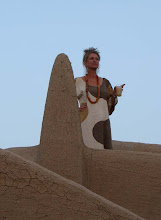
Have been working frantically to send off the proposal for the major project with the British Library to save the Djenne manuscripts. I am just surfacing, having sent the application off to my two learned sponsors, Dr Dmitry Bondarev from SOAS who is doing research on Arabic mss in northern Nigeria and Dr. Constant Hames, a French anthropologist and Arabist. I use a quote from the latter in my application, and I will copy below the passage where it appers:
'More than 50% of the Djenné manuscrips were found to deal with ‘esoteric’ subjects. Although there has been no thematic or quantitative study done on the Timbuktu material in this respect, it is probable that this is a much higher percentage than the Timbuktu manuscripts, which deal in the main with more orthodox Islamic subjects. Both Djenné and Timbuktu have been famous for a thousand years as centres of Islamic learning. Even today Djenné boasts about 50 Koran schools where little talibes or garibous learn verses from the Koran by heart, under the guidance of their Koran master, a Marabout. However, Djenné in particular is also famous for another sort of learning: the Djenné Marabouts are known throughout West Africa as experts of Maraboutage, or the subject listed under ‘esotericism’ in Appendix 2 of the EAP 269 Pilot Project report.
The Dutch anthropologist Geert Mommersteeg’s ‘Dans la Cite des Marabouts’ (Grandvaux, 2009,) and British anthropologist Trevor Marchand’s The Masons of Djenne’ (2009, Indiana University Press) both deal, in various ways, with the ‘two sorts of knowledge’ represented on the one hand by the traditional Islamic teaching of the Koran Schools, and on the other hand the esoteric practices which can be grouped under the heading of maraboutage. The French anthropologist Constant Hamès bemoans the ‘blind spot’ which has existed with regards to written information on the transmission of occult knowledge on these subjects in his preface to Mommersteeg:
‘ As to the works employed to this end; as to the content in the collections of recipes used by the marabouts, there are but rare notations and references… This remains therefore a blind spot in the research concerning the teaching methods in the transmission of esoteric knowledge.’ (my translation).
It seems more than probable that the manuscripts of Djenné will finally provide this missing material. This will surely be of immense interest to scholars in the fields not only of religious history and anthropology but of West African history in general.'
The first picture shows a manuscript attacked by termites, one of the gravest dangers that threathens the Djenne manuscripts. This picture was attached to the application, to highlight the danger to the manuscripts if the project is not allowed to take place.
The picture above is an example of Djenne illumination work. This manuscript is about 100 years old. Today the practise of illumination is sadly beginning to die out here, although the copying on of Arabic verses on wooden tablets by the little Talibes in the many Koran schools still carries on.
Timbuktu has had much funding and much interest in everything that has to do with manuscripts, including the celebration of one or two local calligraphers, one of whom has been invited to South Africa to exhibit his work.
We are now going to try and kickstart Djenne calligraphy again- it is not too late. It is now Maolud, the period before the celebration of the birth of the Prophet Mohammed. Every night the whole of the city of Djenne resounds with hundreds of voices from all the Koran schools who join in a rythmical and melodious chanting, lulling me to sleep as the sound carries across the moonlit municipal foot ball field which separates me from the city of Djenne.
Hotel Djenne Djenno had indeed intended to fund a football Cup this year, but we have now changed our minds. Hotel Djenne Djenno is sponsoring a calligraphy competition instead, open to everyone in Djenne! The competitors are invited to present their work to the Djenne Manuscript library by the last day of Maolud, when a committee of judges (yes, of course, I will feature among them...)will select the three winners who will receive a money price. Their work will then be displayed in the Library.
More about this anon. I will show you the winners with their winning entries of course!
And finally, Tanita Tikaram, the singer/songwriter has featured me once more, posting my answers to the questionnaire she sent me...thank you Tanita! www.tanitatikaramblog.blogspot.com


0 Comments:
Post a Comment
<< Home